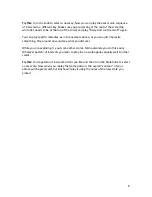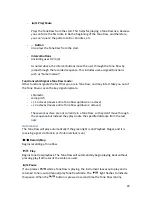
(Record/Stop)
:
Initiates recording Tone Row pattern (LED turns red), or stops and exits Tone Row
playback (LED turns off). (Please see “Tone Row” section below.)
If there is a Tone Row in memory, but the tone row is neither playing nor in pause, then
press and hold Scale Knob and then press
to perform the Tone Row once through
(“Play Once”).
(
Play/Pause)
:
Plays the Tone Row from the beginning of the sequence. If an internal or external clock is
detected, then the Tone Row will continue to play automatically. If you are currently
recording a Tone Row, pressing this will terminate the recording early, sending it into
playback.
Once the Tone Row is playing back,
toggles a pause in the Tone Row, leaving the
user still in Tone Row playback.
LCD screen
Key And Scale Indicators
The top left and right of the display indicate the key and scale we are currently in,
respectively
.
Solfege Wheel
Graphically displays notes of scale, note position and name.
Octave Display
Boxes below the solfege wheel indicate current octave and number of octaves in
the current note range.
User Buttons
These perform user-defined functions. See “User-Assignable Buttons” section below.
Undo (
⤺
)
This is the “undo” key; it returns you to the previous note. Besides being useful in
general playing, this is also helpful in learning a new melody. If you hit the wrong note,
then press
⤺
and you will hear the previous (different) note and this time hopefully you
can locate the correct button to press. That is,
⤺
undoes the last (non-zero) move.
If in a Tone Row,
⤺
restarts the Tone Row when it is pressed (when in Play or Auto Play
menu).
Interval Buttons
These nine buttons (-4,-3,-2,-1,0,+1,+2,+3,+4) form a kind of keyboard - an interval
keyboard. They are a good starting point for making music. Let’s take a trivial example: If
10











































